Ensuring a comfortable and efficient pumping experience begins with finding the right breast shield size. At Annabella, we understand the importance of a customized fit tailored to your unique anatomy. Our breast shields are designed to accommodate most women within the 18-24 mm range, offering adjustability for optimal comfort and performance. Discovering your ideal breast shield size is easy with our simple measuring tool and adjustable design. Let's explore the steps to finding your perfect fit and optimizing your pumping experience.
Why Breast Shield Sizing Matters:
Choosing the correct breast shield size is essential for several reasons:
-
Comfort: A properly fitting breast shield ensures comfort during pumping sessions, reducing the risk of discomfort, pain, or nipple trauma.
-
Efficiency: An appropriately sized breast shield facilitates efficient milk expression by creating a proper seal around the breast, maximizing suction and milk flow.
-
Milk Supply: The right breast shield size promotes adequate milk removal, helping to maintain or increase milk supply over time.
-
Prevention of Issues: Using an incorrectly sized breast shield can lead to problems such as reduced milk output, nipple soreness, or engorgement.
Consequences of Incorrect Breast Shield Sizing:
If your breast shield is too small:
-
Nipple Compression: A breast shield that is too small may compress the nipple, leading to discomfort, restricted milk flow, and potential tissue damage.
-
Reduced Milk Output: Inadequate breast shield size can impede milk flow, resulting in decreased milk output during pumping sessions.
-
Nipple Pain: Nipple soreness and discomfort are common symptoms of using a breast shield that is too small, as it may rub against the delicate skin of the nipple.
Example: Laura, a new mom, experienced nipple pain and discomfort during her pumping sessions. After consulting with a lactation specialist, she discovered that her breast shield was too small, causing nipple compression. Switching to a larger size provided immediate relief and improved milk flow.
If your breast shield is too large:
-
Ineffective Suction: An oversized breast shield may fail to create a proper seal around the breast, leading to decreased suction and inefficient milk removal.
-
Incomplete Emptying: Inadequate suction can result in incomplete breast emptying, increasing the risk of engorgement, plugged ducts, or mastitis.
-
Discomfort: A loose-fitting breast shield may cause discomfort or irritation during pumping, impacting the overall pumping experience.
Example: Sarah, a nursing mother, noticed that her breast pump was not effectively emptying her breasts and she often felt engorged between feedings. After consulting with a lactation consultant, she learned that her breast shield was too large, resulting in ineffective suction. Switching to a smaller size improved her pumping experience and relieved her discomfort.
Additional Tips for Pumping Success:
-
Regular Monitoring: Periodically reassess your breast shield size and tongue height level to ensure optimal fit and comfort, especially as your body changes during breastfeeding.
-
Proper Maintenance: Keep your breast pump clean and well-maintained to preserve suction efficiency and ensure hygienic pumping sessions. Regularly replace worn-out parts to maintain optimal performance.
-
Seeking Support: If you experience any discomfort or difficulty with your breast pump, don't hesitate to reach out to our customer service team or consult with a lactation specialist for personalized assistance and guidance.
-
Optimize Pumping Environment: Create a comfortable and relaxing pumping environment to enhance milk letdown and expression. Find a quiet space where you can relax and focus on your pumping session.
-
Stay Hydrated and Nourished: Maintain proper hydration and nutrition to support milk production and overall well-being. Drink plenty of water throughout the day and consume a balanced diet rich in nutrient-dense foods to fuel your body and optimize milk supply.
-
Establish a Pumping Schedule: Consistency is key to maintaining milk supply and maximizing pumping efficiency. Establish a regular pumping schedule that aligns with your baby's feeding routine to ensure adequate milk production and storage.
-
Breast Massage and Warm Compresses: Incorporate gentle breast massage and warm compresses into your pumping routine to encourage milk flow and empty the breasts more effectively.
-
Adapting to the Wrong Size: If you find that your breast shield size is slightly off, you can still pump with caution. However, be mindful of any discomfort, reduced milk output, or signs of nipple trauma. Consider adjusting the tongue height level or seeking assistance to find a better fit.
Pumping with Confidence
Whether you're a new mom navigating the world of breastfeeding or a seasoned pumper seeking optimal performance, we're here to support you every step of the way. Discover the perfect fit for your pumping journey and experience the difference with Annabella breast pumps.
Note: If you have any questions or need further assistance in finding the right breast shield size, please don't hesitate to reach out to our customer service team. We're here to help you achieve pumping success.







